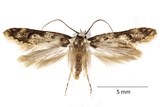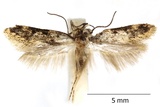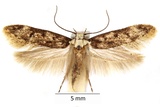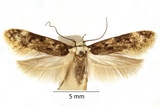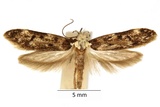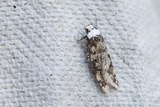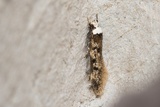Endrosis sarcitrella (Linnaeus, 1758) Species
Last modified: Dec. 8, 2025, 5:54 p.m.
A common species throughout Belgium, since the earliest observations recorded from all provinces. Very often found indoors.
Details
- Classification
- Family: Oecophoridae > Subfamily: Oecophorinae > Genus: Endrosis > Species: Endrosis sarcitrella
- Vernacular names
- Witkopmot (NL), White-shouldered house moth (EN), Teigne de la colle (FR), Kleistermotte (DE)
- Synonyms
- Endrosis lactella (Denis & Schiffermüller, 1775) and Endrosis betulinella (Hübner, 1813)
- First mention in Belgium
- De Sélys-Longchamps E. 1844. Énumération des insectes Lépidoptères de la Belgique. — Mémoires de la Société royale des Sciences de Liége 2: 1–35. On page 24 (as Lita betulinella H.). view page
- Status
-
Native
Distribution
Caterpillar
Whitish, head and prothoracic plate brown.
Cocoon/pupa
The larva lives in a silken gallery mixed with frass and food-particles.
Bionomics
The eggs are oviposited on dead organic material.
The caterpillar feeds from a slilken gallery in which frass is used.
Pupation takes place in the feeding place of the larva.
This species can become very common and it is then regarded as a pest species. It can cause damage to all stored food products, but also wool, paper and even insect collections.
Flight periods
Two to four generations a year. The adults have been observed in all months of the year, observations during the winter months mainly indoors.
Observed on
- Substrates:
- Stored products (grain, rice, nuts, etc.), Fungi, Nests of birds, Decaying vegetable matter and Decaying animal matter
Dry vegetable matter, paper, rotten wood, fungus, dead insects, in birds' nests, in bee-hives, etc.
Habitat
Houses, storage rooms, nests of birds, gardens.
